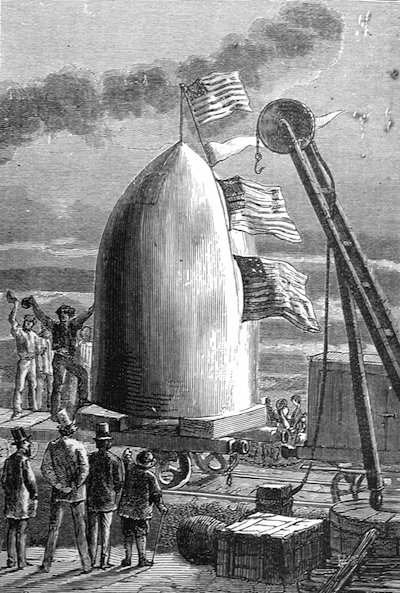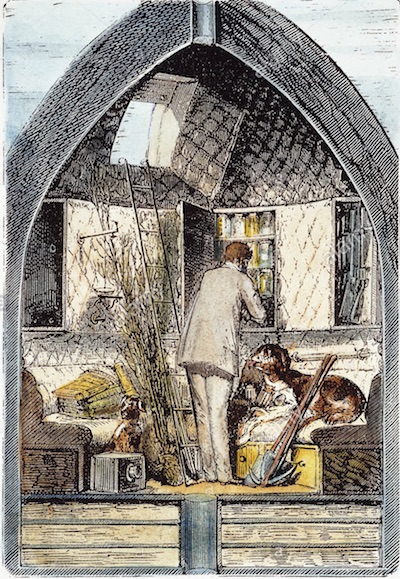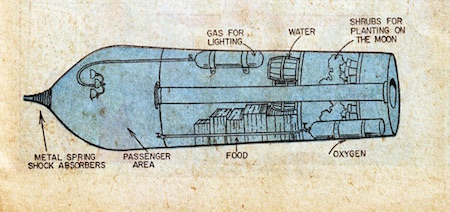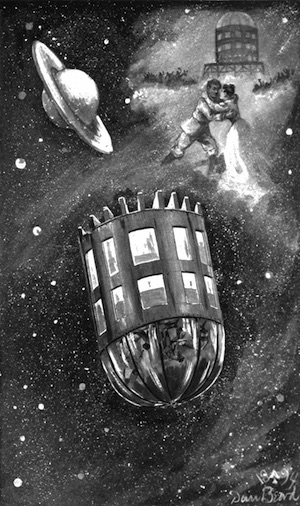Science Fiction
Dictionary
A B C D E F G H I J K L M N O P Q R S T U V W X Y Z
Latest By
Category:
Armor
Artificial
Intelligence
Biology
Clothing
Communication
Computers
Culture
Data Storage
Displays
Engineering
Entertainment
Food
Input Devices
Lifestyle
Living Space
Manufacturing
Material
Media
Medical
Miscellaneous
Robotics
Security
Space Tech
Spacecraft
Surveillance
Transportation
Travel
Vehicle
Virtual
Person
Warfare
Weapon
Work
"Conspiracy theories are big because they're comforting. Any conspiracy is infinitely less multiplex than the real deal, which is multiplex to the point of being unknowable."
- William Gibson
| Projectile-Vehicle | ||
| A projectile, or shot, capable of enclosing passengers and being safely hurled to the moon by an enormous cannon. |
A great cannon having been cast and placed in the soil of Florida, what sort of projectile could be used to send several intrepid passengers to the Moon?
| The projectile had now to be filled to the depth of three feet
with a bed of water, intended to support a water-tight wooden
disc, which worked easily within the walls of the projectile.
It was upon this kind of raft that the travelers were to take
their place. This body of water was divided by horizontal
partitions, which the shock of the departure would have to break
in succession. Then each sheet of the water, from the lowest
to the highest, running off into escape tubes toward the top of
the projectile, constituted a kind of spring; and the wooden
disc, supplied with extremely powerful plugs, could not strike
the lowest plate except after breaking successively the
different partitions. Undoubtedly the travelers would still
have to encounter a violent recoil after the complete escapement
of the water; but the first shock would be almost entirely
destroyed by this powerful spring. The upper parts of the walls
were lined with a thick padding of leather, fastened upon springs
of the best steel, behind which the escape tubes were completely
concealed; thus all imaginable precautions had been taken for
averting the first shock; and if they did get crushed, they
must, as Michel Ardan said, be made of very bad materials.
 (19th century drawing of the projectile) The entrance into this metallic tower was by a narrow aperture contrived in the wall of the cone. This was hermetically closed by a plate of aluminum, fastened internally by powerful screw-pressure. The travelers could therefore quit their prison at pleasure, as soon as they should reach the moon.
 (19th century drawing of projectile interior) Light and view were given by means of four thick lenticular glass scuttles, two pierced in the circular wall itself, the third in the bottom, the fourth in the top. These scuttles then were protected against the shock of departure by plates let into solid grooves, which could easily be opened outward by unscrewing them from the inside. Reservoirs firmly fixed contained water and the necessary provisions; and fire and light were procurable by means of gas, contained in a special reservoir under a pressure of several atmospheres. They had only to turn a tap, and for six hours the gas would light and warm this comfortable vehicle.
 (Diagram of the Verne projectile) There now remained only the question of air; for allowing for the consumption of air by Barbicane, his two companions, and two dogs which he proposed taking with him, it was necessary to renew the air of the projectile. Now air consists principally of twenty-one parts of oxygen and seventy-nine of nitrogen. The lungs absorb the oxygen, which is indispensable for the support of life, and reject the nitrogen. The air expired loses nearly five per cent. of the former and contains nearly an equal volume of carbonic acid, produced by the combustion of the elements of the blood. In an air-tight enclosure, then, after a certain time, all the oxygen of the air will be replaced by the carbonic acid-- a gas fatal to life. There were two things to be done then-- first, to replace the absorbed oxygen; secondly, to destroy the expired carbonic acid; both easy enough to do, by means of chlorate of potassium and caustic potash. |
| Technovelgy from From the Earth to the Moon,
by Jules Verne. Published by Pierre-Jules Hetzel in 1867 Additional resources -
|
Note the four basic elements of this spacecraft:
This illustration accompanies an 1880 Pall Mall Gazette article about Verne's work.
That, and the few comforts required by gentlemen, are all that are needed!

(From an article describing Astor's spaceship)
The first truly scientific work on space flight was not published until Konstantin Ziolkovsky (Tsiolkovsky) published his seminal paper "Exploration of Space With Reactive Devices" in 1903. He showed how a rocket ship could be used to send humans beyond Earth orbit, and included calculations that led him to believe that multiple-staged vehicles would increase the payload (the Chinese had experimented with this idea earlier). NASA paid to translate all of his works into English in 1965.
Comment/Join this discussion ( 0 ) | RSS/XML | Blog This |
Additional
resources:
More Ideas
and Technology from From the Earth to the Moon
More Ideas
and Technology by Jules Verne
Tech news articles related to From the Earth to the Moon
Tech news articles related to works by Jules Verne
Projectile-Vehicle-related
news articles:
- Sushi In Space!
- Private Space Flight At 'Inflection Point'
- ESA Plans Akon Projectile To Europa ala Jules Verne
| Europa Clipper Plate Carries A Special Message |
| China Wants To Build Mega Space Ships |
| Dream Of Building Your Own Rocket? |
| Used Dragon Cargo Spacecraft Will Fly Again |
Want to Contribute an
Item?
It's easy:
Get the name of the item, a
quote, the book's name and the author's name, and Add
it here.
| <Previous | Next> |
|
|
|
Technovelgy (that's tech-novel-gee!) is devoted to the creative science inventions and ideas of sf authors. Look for the Invention Category that interests you, the Glossary, the Science Fiction Invention Timeline, or see what's New.
|
Science Fiction
Timeline
1600-1899
1900-1939
1940's 1950's
1960's 1970's
1980's 1990's
2000's 2010's
'The leg was to function, in a way, as a servo-mechanism operated by Larry’s brain...'
'The observation vehicle was of that peculiar variety used in conveying a large number of people across rough terrain.'
'The real border was defended by... a swarm of quasi-independent aerostats.'
'I ... set my automatic astronomical instruments to searching for a habitable planet.'
'...haven't you a section of the factory where only robot labor is employed?'
